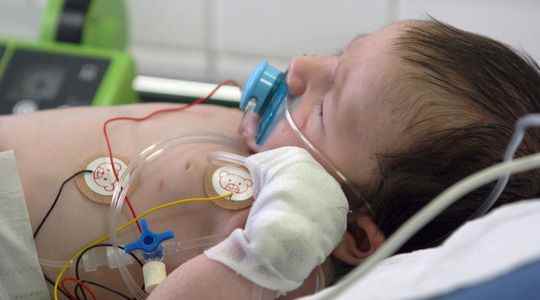Hauts-de-France, Ile-de-France, New-Aquitaine, Occitanie… What do these four regions have in common? They all passed to the stage of the bronchiolitis epidemic. Ten others, Auvergne-Rhône-Alpes, Bourgogne-Franche-Comté, Bretagne, Centre-Val de Loire, Grand-Est, Guadeloupe, Guyana, Martinique, Pays de la Loire and Provence-Alpes-Côte d’Azur are considered in a preliminary phase.
The last few days have shown a “continued increase in bronchiolitis surveillance indicators in children under 2 years old”, according to a weekly report from the French public health agency, this Friday, October 14. Bronchiolitis is a mostly mild, common, and highly contagious respiratory disease, especially in infants 2 to 8 months of age, where it causes coughing and labored, rapid, wheezing breathing. Every year in France, 30% of infants under the age of two are affected by it and it is the leading cause of hospitalization in children under the age of one.
A total of 2,058 children under the age of two went to the emergency room for bronchiolitis in the week of October 3 to 9, a clear increase compared to the previous week. Nearly 660 were eventually hospitalized. The number of hospitalizations is thus higher than what is usually observed at the beginning of October, confirming the scenario of an earlier epidemic for the second year in a row. “The epidemic is a fortnight in advance and we are seeing an increase in forms that require hospitalization”, reports to L’Express Christèle Gras-Le Guen, president of the French pediatric society. “We must expect an impact on pediatric services”, warned this Friday Public Health France (SPF).
Pediatric services fear being “poor”
In the field, caregivers hold a similar speech, in a persistent context of lack of staff in the hospital, causing the closure of “many beds” in hospitals, both in intensive care units and in pediatrics, recalls Christèle Gras-Le Guen. “Paediatrics is in such a state that we are powerless to deal with this epidemic. I don’t know how we are going to manage it”, is alarmed the head of the pediatric department at the Nantes University Hospital.
“I would not say that we are cracking up for the moment, but we feel that it is starting to climb”, for her part testified to AFP Noëlla Manquin, childcare nurse at the Parisian hospital Robert- Debre. “We have children arriving and who are (in a condition) much more serious than a week ago: we will keep them much longer in the emergency room”, she detailed. “The children who are hospitalized in intensive care for bronchiolitis are toddlers, under three months old who sometimes just leave the maternity ward”, recalls Christèle Gras-Le Guen.
In an attempt to unclog hospitals, the pediatrician “wishes” that the government “help them launch prevention campaigns from maternity”. With a clear message intended for families: respect for barrier gestures, such as against Covid-19, in particular wearing a mask and regular hand washing. “We must avoid large family gatherings, avoid kisses, passing the baby from hand to hand, baptisms… Everything must be done to ensure that toddlers are kept safe from the virus during their first three months,” she said.
Will the All Saints holidays curb the epidemic?
Normally, the bronchiolitis epidemic follows the same seasonal pattern from one year to the next: it starts between the end of October and mid-November, reaches a peak in December, ends at the end of January or even the end of February. But this temporality has been affected since Covid-19 in many countries. The 2020-2021 epidemic was much later, with a start in mid-February 2021, and had a lesser impact than usual. Conversely, the 2021-2022 epidemic was earlier “and very intense”, recalls Christèle Gras-Le Guen, in a context of the end of confinements. It started at the beginning of October and had a greater impact on the whole season than usual.
A slight improvement could occur thanks to the school holidays of All Saints (October 22 – November 7). “School plays a major role in the transmission of bronchiolitis. The All Saints holidays will certainly slow the epidemic before a rebound when school resumes, as observed last year” , notes Christèle Gras-Le Guen. For the rest, “we will remain very careful because of the circulation of Covid-19 and the potential competition” of the two viruses, for her part clarified this Friday Sophie Vaux, of Public Health France, during a press briefing. .
Good medical news may arrive in 2023, with the possible arrival of a monoclonal antibody against the bronchiolitis virus “from which we hope for miracles”, recalls Christèle Gras-Le Guen. On September 16, Sanofi obtained the green light from the Committee for Medicinal Products for Human Use (CHMP) of the European Medicines Agency for nirsevimab. This one, jointly developed by the British AstraZeneca and the French Sanofi, which will market it under the name Beyfortus, is an antibody designed to protect infants throughout the circulation season of the respiratory syncytial virus (RSV), a virus with the origin of bronchiolitis.
The CHMP issued a favorable opinion and recommended the approval of Beyfortus for the prevention of lower respiratory tract infections caused by RSV in newborns and infants, during the first season of circulation of the virus that they face. If subsequently approved by the European Commission, Beyfortus will become the first and only single-dose passive immunizing agent indicated for all infants, including those who are healthy, born at term or prematurely, or those with certain conditions healthcare, Sanofi said.
